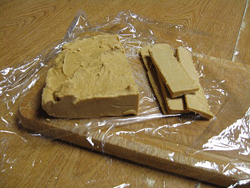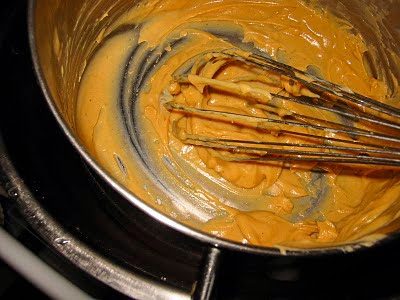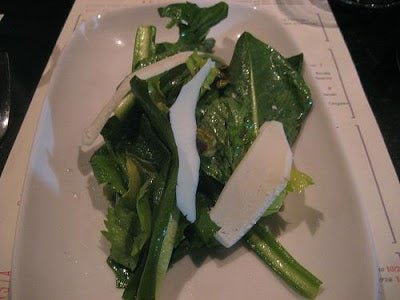Many years ago we received an anonymous request from one of our customers:
I found your website and I am wondering if you have a recipe for a Norwegian cheese my Grandmother used to make. My mother said it was called Prim-ost, a light beige in color and very sweet. She thinks it was made of milk with rennet? I would be very interested in the recipe.
Our response in the “Customers Looking for Recipes” section was as follows:
This response sat undisputed on our website for years until we recently received this note from Louise Kent in Denmark:
I just read your Q and A on Prim-ost! The answer you gave is not quite correct!I am from Denmark and my grandmother was Norwegian. Prim-ost is a Norwegian cheese, as well as Myseost. But Myseost is a hard cheese and Prim-ost is a cream cheese. It is not the same. Prim-ost is sweeter than Myseost. Myseost can be bought in different types. The mildest one is made from cream, the middle one is half cow milk and half goat milk, and the strongest one is all goat milk.
Just wanted to tell you because I’m a big enthusiast when it comes to this Norwegian specialty.
Part 2 – About Mysost
Mysost is a Norwegian cheese made from caramelized cow’s milk whey, often the whey left over after making traditional curd cheese. When made with goat’s whey, the cheese is called gjetost. They are unusual–not what you’d necessarily expect when someone tells you they are serving you cheese. Both cheeses are smooth, sweet, sour, salty, slightly brown–and deliciously different.
The recipe calls for only two ingredients. We purchased a couple of quarts of whey from our dairy farmer, combined it with a little cream, and put it on to heat. (If you prefer, you can make it with only whey, although your cheese will be slightly grainier.) You can certainly use your own whey–that made after draining yogurt to make yogurt cheese will even work. I don’t think it is particularly easy to find commercial whey, however.
We brought the whey up to a full boil then turned down the heat a bit. After several hours (4 for us, but sometimes as much as 12 hours) at a gentle boil, the whey had reduced to a fudge-like consistency. After beating it severely, we cooled it in its pan over a bowl of iced water and poured it into a little buttered glass bowl.
Mellowing in the refrigerator for 24 hours helps the flavor of mysost. But I couldn’t wait:
Part 3 – About Gjetost

Last summer I helped in the kitchen of a local retreat center when they were hosting a Sons of Norway Norwegian camp. It was there I tasted a goat cheese called Gjetost. There are different spellings as well as names for this cheese. The Norwegians place it on bread (just a very thin slice) along with raspberry jam, and it was delicious! I determined then and there I was going to learn how to make it.
The lady that introduced me to it stated that the process needed both goat and cow milk, but I have since discovered there are three cheeses that can be made: whey from just goat milk, a combination of goat and cow milk whey, and whey from only cow milk. Our goats are dry now, so I will use cow milk until our goats are milked again in the spring.
I found a recipe on the Fankhauser cheese website, but it seemed hard to follow. About a year ago I purchased Ricki Carroll’s book, Home Cheese Making, and found the recipe in there. I had lots of questions after reading her recipe, but forged ahead and made a batch.

Mysost (another name is Primost) is the result of taking the whey byproduct from making cheese and slowly boiling it down to where it caramelizes and thickens. Cream is added towards the end of the process, but that’s all there is to the ingredients. This whole process has taken me from 6 to 12 hours. I can see why it’s recommended that a wood cookstove be used instead of a conventional stove top — that’s a lot of electricity!
The first time I made a batch the end result was grainy, but that has only happened one other time and I think I’ve cooked up 5 batches. Each batch has given us approximately 30 ounces out of about 7 quarts of whey. Jim, Peter and I enjoy it on toast for breakfast, along with our homemade raspberry jam. It’s easy to make if you have the time to spend in the kitchen close to the stove.
Part 4 – More about Whey Cheeses
All this inspired us to do some further research about these cheeses:

Apparently, in 1863, a 17 year old home cheese maker in Norway had the idea of adding cream to whey, bringing it to a boil and reducing it into cheese. She created a brown cheese which everybody liked.
She was able to sell it and it is actually said to have saved her valley financially in the 1880’s. When she was 87, in 1933, the King of Norway gave her a medal for her invention. To this day, 25% of the cheese consumed in Norway is Brunost (brown cheese).
Through the years, many variations of her cheese were developed, including:
Ski Queen brand Gjetost – Made from half cow’s milk, half goat’s milk. This is the mild form most of us have tried here in the U.S.
Prim – Made from cow’s milk with sugar added. This is boiled for less time than all other kinds.

Ekte Gjetost (real Gjetost) – Made from goat’s whey. This has a darker color and richer flavor than Ski Queen brand Gjetost.
Flotemysost – Made from cow’s milk whey, enriched with cow’s milk cream.
Gudbrandsdalsost – Made from both cow’s and goat’s milk (10 to 12 % goat’s milk). This is the most popular form in Norway.
Mysost – Made from all cow’s milk whey. In Norwegian, “myse” means “whey” and “ost” means “cheese.”
In our book, Home Cheese Making, there is a recipe for Mysost (p.150) and a recipe for Gjetost (p.151). We think Prim-ost is made the same as Mysost, but boiled for less time so that it remains spreadable. If anyone has an actual recipe for Prim-ost, please share it with us. We do love our brown cheese!




















































































































































